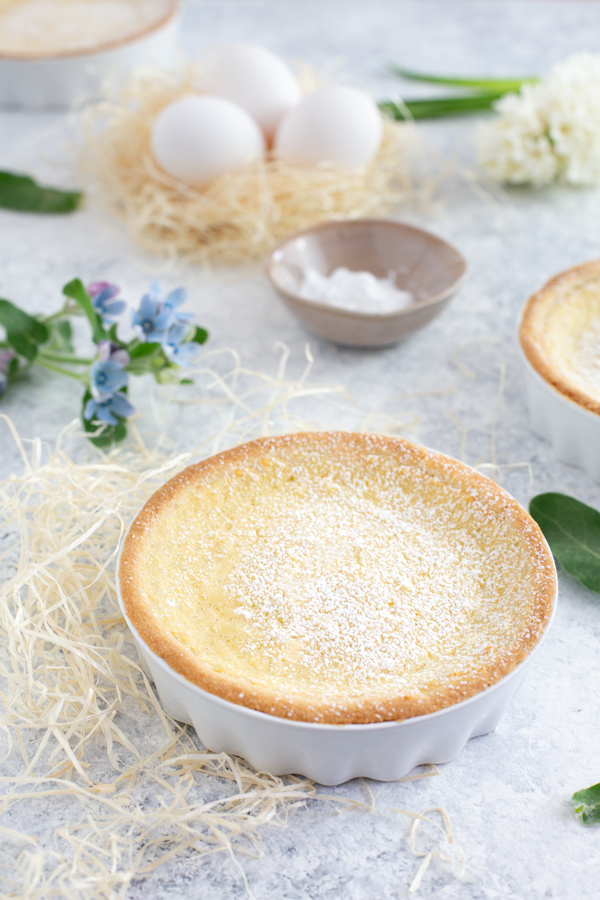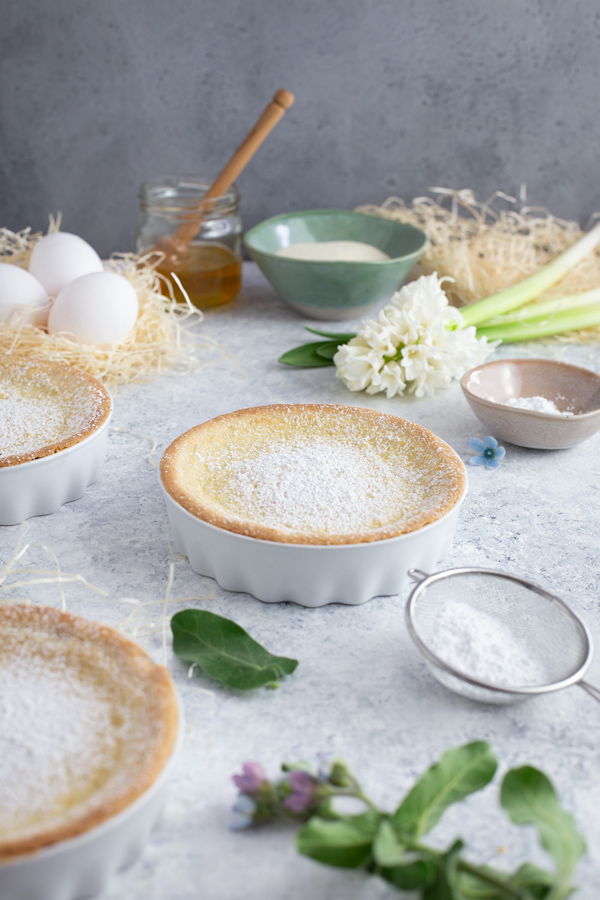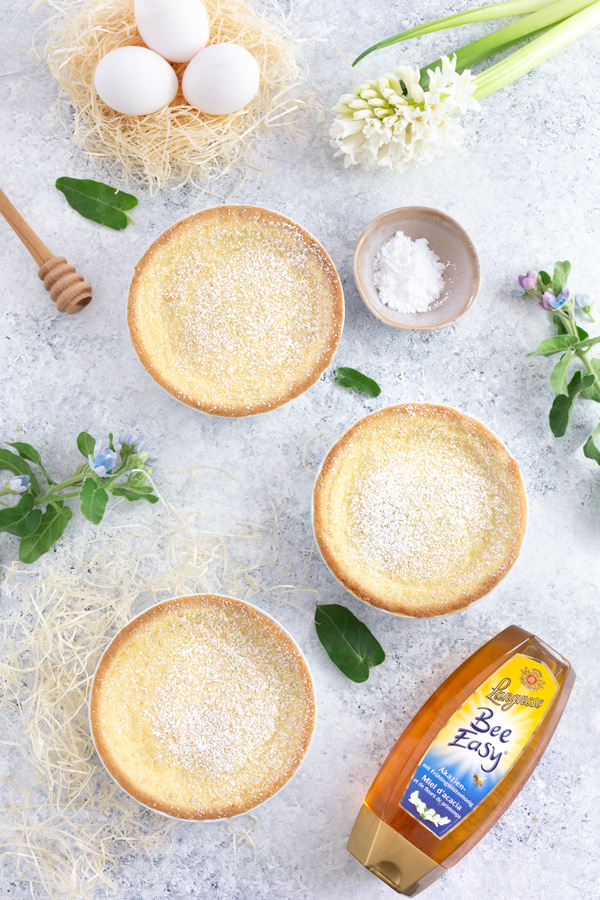Swiss Easter Cakes
07 April 2020 by Natanja
Diesen Beitrag gibt es auch auf Deutsch
Decadent Swiss Easter Cakes with semolina pudding filling nestled inside a sweet tart crust.

Easter is approaching and I have just the recipe, to celebrate the joyous occasion. If you have never heard of Osterchüechli (a.k.a Swiss Easter Cakes) before, you are in for a treat. These little tartelettes, that are actually not tarts at all, are something quite unique. While the outside is a traditional tart crust, exactly the same that you would use for a standard tart recipe, the filling is probably something you’ve never had before.
…unless, of course, you’ve had semolina pudding before, since this is very similar to it. Semolina pudding is typically enjoyed in various European and Middle Eastern countries, most of them having their own version of this tasty pudding. It’s quite filling, as the base is a combination of semolina and whole milk (though some use water) to which sugar and spices are added.

Growing up, my mom used to serve semolina pudding to us kids regularly. It’s easy to prepare and you are certainly not hungry anymore after a bowl of it. Thus, it was the perfect dessert for us kids, especially my brother, who had constant growth spurts and could eat for days growing up. While he enjoyed his with honey, I used to sprinkle completely cover mine with sweetened cocoa powder. It was definitely one of our favorite desserts, that mom prepared for us.
As an adult, I haven’t had semolina pudding in quite a while…until I moved to Switerzerland and got to know Osterchüechli, that have this incredibly similar filling. Osterchüechli, also known as Osterfladen, is a very traditional Easter dessert. I’d argue that every Swiss citizen knows this dessert, most of them having grown up with it.
So I decided to make my own version of it. Swiss Easter cakes can either by made with semolina or rice. For today’s recipe, we are making the version with semolina.

How to make Swiss Easter Cakes
To begin, you’ll need to make (or buy) the tart crust. It’s quite easy to make (as you can tell from my super thorough guide about how to make sweet tart crust) but it does take some time to come together, as it needs to chill in-between steps. I typically like to make the tart crust a day ahead, to split the steps and not do everything in one day. Or I even have a frozen tart crust on hand, which I can use. You can prep the dough and let it rest in the fridge over-night, or you can already place it into your tart pans, wrap them with plastic wrap and let the dough chill in the tart pans for 1-2 days until you are ready to use them.
For the filling, it’s important to note, that it also needs time to chill in-between steps before you can pour it into your tart shells. As you can tell, this recipe does require a bit of planning, since it’s not something you can do last-minute. But don’t leave just yet, this dessert is definitely worth it!

Ingredients
Since the filling for the Easter Cakes is made with simple ingredients, it’s important to use only the best quality of ingredients so your cakes will taste delicious. Definitely use whole vanilla beans and freshly grated lemon zest. You won’t be sorry! While Osterchüechli are traditionally sweetened with sugar, I decided to opt for honey. This gives the cakes a little more flavor and I actually preferred it over the sugar version. It’s important to use a light flavored honey, such as the Akazien- mit Frühlingsblütenhonig by Langnese Honig. This is a light-colored honey, which gives just the right amount of flavor, without being overpowering. Due to its packaging in a squeezy-bottle, it’s also great for baking, since it’s super easy to measure out the right amount.
How to serve Swiss Easter Cakes
Ok so let’s get to the best part about this dessert, namely, how to enjoy it. In Switzerland it’s typically enjoyed for brunch on Easter Sunday with coffee. However, stores tend to sell it a month beforehand, so people can already enjoy the traditional dessert in advance. While it’s mainly enjoyed at Easter, I think it makes a tasty dessert for anytime guests come over or you just want to make something special.
I wish you a happy Easter!
Print
Swiss Easter Cakes
- Prep Time: 35 minutes
- Cook Time: 35 minutes
- Total Time: 2 hours 20 minutes (includes chilling time)
- Yield: 4 cakes 1x
Description
Decadent Swiss Easter Cakes with semolina pudding filling nestled inside a sweet tart crust.
Ingredients
- 1x unbaked sweet tart crust
- 4 tablespoons rum, optional
- 2 tablespoons raisins, optional
- 2 medium eggs
- pinch of salt
- 60g butter (1/2 stick), softened
- 5 tablespoons honey, such as Langnese Akazien- mit Frühlingsblüttenhonig
- 1 teaspoon lemon zest (~ zest of 1 small lemon)
- 1 vanilla bean
- 500 ml milk (2 cups)
- 80g semolina (1/2 cup)
- 4 tablespoons apricot jam
- powdered sugar for dusting
Instructions
- If using, bring the rum to a boil, remove from heat and add in the raisins. Let them soak for at least 1 hour, the longer the better.
- Separate the egg yolks from the whites and beat the egg whites with a pinch of salt until stiff peaks form. Store in the fridge until needed.
- Combine the butter, honey and lemon zest and beat until smooth with a hand mixer. Continue mixing and add in the egg yolks one at a time.
- Slice the vanilla bean in half lengthwise and scrape out the seeds. Add the milk along with the vanilla bean seeds and pods to a sauce pan and bring to a boil, stirring constantly.
- Reduce the heat to medium-low, remove the pods, add in the semolina and cook for a few minutes until the mixture has thickened and has a pudding-like consistency. Let it cool down to room temperature.
- In the meantime, roll out your dough on a floured surface and place into the tart pans. Prick the bottom with a fork a bunch of time. Let the dough chill in the tart pans for at least 30 minutes in the fridge or 10 minutes in the freezer.
- Once the semolina mixture has cooled, remove the skin and mix together with the butter mixture until smooth. Lastly gently fold in the whipped egg whites.
- Spread a layer of apricot jam onto the bottom of the tart crusts and sprinkle a few rum infused raisins on top. Then add the filling on top.
- Place into a cold oven and bake at 180C (350F) on the middle rack until golden brown, for about 35 minutes. (If the crust should become too dark, cover with aluminum foil.)
- Let the cakes cool completely, dust with powdered sugar and serve.
Notes
Prep time excludes the dough recipe.
Thank you to our friends at Langnese Honig for sponsoring this post.
MORE FROM MY SITE
Disclosure: This post may contain affiliate links, but these are all products I highly recommend. I won’t put anything on this page that I haven’t verified and/or personally used.
Tagged With: cake, Easter, Easter brunch, Easter dessert, Osterchüechli, Swiss, Swiss Easter Cakes
Filed Under: Cakes, Dessert, Seasonal, Spring & Easter Recipes, Trending now
